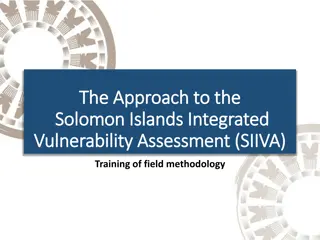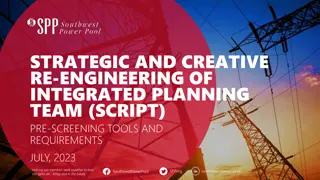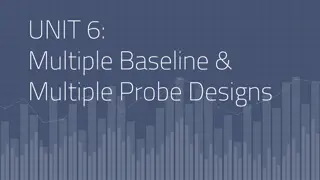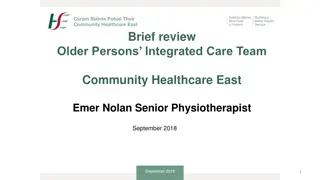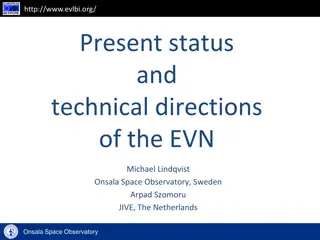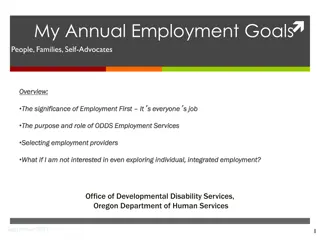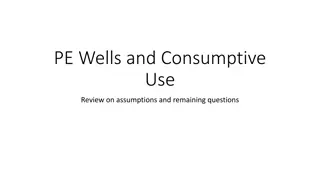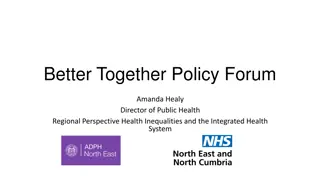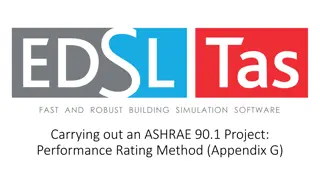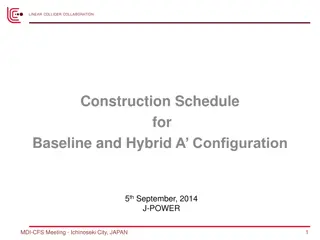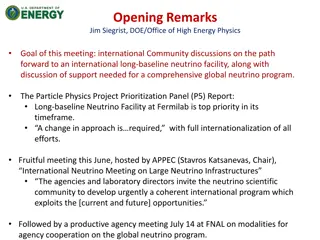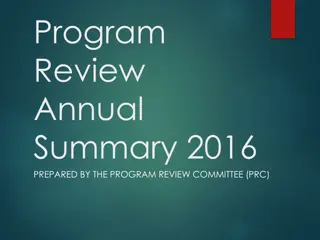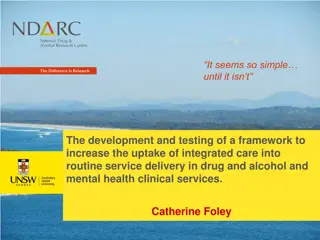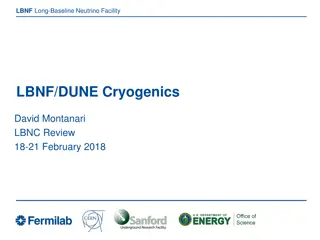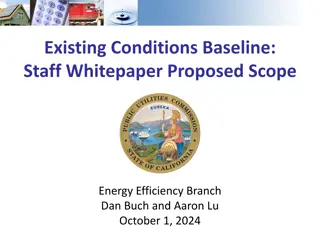Integrated Baseline Review Out Brief - Key Objectives and Summary
Promoting knowledge and mutual understanding of the Performance Measurement Baseline (PMB), ensuring its realism and adequacy for project success, identifying risks and opportunities, and establishing mitigation plans are key objectives of the Integrated Baseline Review (IBR). The IBR agenda example provides a structured approach to achieve these objectives. Acknowledgments and a detailed summary of risk areas, including technical, schedule, cost, and resource aspects, are crucial components of the IBR process. Effective management processes play a vital role in ensuring project success by maintaining accurate performance data and addressing risks timely for a clear path forward.
Download Presentation

Please find below an Image/Link to download the presentation.
The content on the website is provided AS IS for your information and personal use only. It may not be sold, licensed, or shared on other websites without obtaining consent from the author. Download presentation by click this link. If you encounter any issues during the download, it is possible that the publisher has removed the file from their server.
E N D
Presentation Transcript
Project Name Integrated Baseline Review Out Brief Date
Out Brief Content Out Brief Content IBR Objectives IBR Agenda Acknowledgments Post IBR Documentation Requests IBR Summary Risk Areas Detailed Assessment Overall Assessment Path Forward 2
IBR Objectives IBR Objectives Promote knowledge and mutual understanding of the Performance Measurement Baseline (PMB) and that is being implemented properly. Ensure PMB is realistic and adequate for accomplishing all the authorized work within the authorized schedule and budget. Gain insight into technical, schedule, cost, resource, and management process risk areas. Ensure risks/opportunities are identified, quantified (cost/schedule impacts), and mitigation plans established. Identify previously unknown risks and to develop mitigation plans to minimize any negative effects. Ensure objective Performance Measurement Techniques (PMTs) are used all discrete work. Come away with a mutual agreement that the PMB is achievable/executable given the schedule/budget constraints and findings can be resolved in a timely manner. 3
IBR Agenda Example IBR Agenda Example 4
IBR Agenda IBR Agenda 5
IBR Acknowledgements IBR Acknowledgements See Notes for Sample Acknowledgments ideas 6
IBR Summary Risk Areas IBR Summary Risk Areas Management Processes Technical Schedule Cost Resource Technical Risk The ability of the project s technical plan to achieve the objectives of the scope of work. Technical risk includes the effects of available technology, software development capability, design maturity, etc. Schedule Risk The adequacy of the time allocated for performing the defined tasks to successfully achieve the projects schedule objectives. Schedule risk includes the effects on the schedule of the interdependency of scheduled activities to achieve project milestones and support the PM s ability to identify and manage the critical path. Cost Risk The ability of the PMB to successfully execute the project and attain cost objectives, recognizing the relationship between budget, resources, funding, schedule, and scope of work. The quality of the estimates affects the cost risk, which includes the assumptions used for both estimates and resource allocation on the budgets for work items. Resource Risk The ability of personnel, facilities, and equipment, when required to perform the defined tasks needed to execute the program successfully. Resource risk includes the effect of external factors such as loss of availability to competing programs or unexpected downtime that could preclude or otherwise limit the availability of the resources needed to complete planned work. Management Process Risk The degree to which the management processes provide effective and integrated technical/schedule/cost planning and baseline change control. Management process risk includes the ability to establish and maintain valid, accurate, and timely performance data, including data from subcontractors, for early visibility into risk. 7
Technical Risk Evaluation Technical Risk Evaluation Technical Risk: The ability of the project s technical plan to achieve the objectives of the scope of work. Technical risk includes the effects of available technology, software development capability, design maturity, etc. Findings: List Action Items: List It is recommended that the 5 risk charts are prepared for each interview. The Findings and Actions can be transferred to the IBR Findings Log 8
Schedule Risk Evaluation Schedule Risk Evaluation Schedule Risk: The adequacy of the time allocated for performing the defined tasks to successfully achieve the projects schedule objectives. Schedule risk includes the effects on the schedule of the interdependency of scheduled activities to achieve project milestones and support the PM s ability to identify and manage the critical path. Findings: List Action Items: List 9
Cost Risk Evaluation Cost Risk Evaluation Cost Risk: The ability of the PMB to successfully execute the project and attain cost objectives, recognizing the relationship between budget, resources, funding, schedule, and scope of work. The quality of the estimates affects the cost risk, which includes the assumptions used for both estimates and resource allocation on the budgets for work items. Findings: List Action Items: List 10
Resource Risk Evaluation Resource Risk Evaluation Resource Risk: The ability of personnel, facilities, and equipment, when required to perform the defined tasks needed to execute the program successfully. Resource risk includes the effect of external factors such as loss of availability to competing programs or unexpected downtime that could preclude or otherwise limit the availability of the resources needed to complete planned work. Findings: List Action Items: List 11
Management Process Risk Evaluation Management Process Risk Evaluation Management Process Risk: The degree to which the management processes provide effective and integrated technical/schedule/cost planning and baseline change control. Management process risk includes the ability to establish and maintain valid, accurate, and timely performance data, including data from subcontractors, for early visibility into risk. Findings: List Action Items: List 12
Overall Assessment Overall Assessment See Notes for sample Overall Assessment ideas 13
Path Forward Path Forward Program Office submits IBR Log to Project (Generally within 2 weeks from end of interviews) Program Office submits IBR report to Project (Center Specific Requirement) Project provides resolution plan for Findings/Action Items (Mutually agreed upon but generally within 2 weeks after receipt of IBR Log) Program Office (Procurement) issues IBR Close-out Letter after all Findings are closed IBR Closeout Report - That does not happen until the last Finding is closed. An IBR Report can go out after the IBR, just promote not saying the IBR is closed. 14
Back Back- -Up Up 15
Technical Risk Evaluation Criteria Technical Risk Evaluation Criteria Excellent (Green) Contractor/in-house project has developed a comprehensive technical baseline plan which covers all efforts within the SOW/Project Plan, is consistent with contract/project requirements, and has adequate definition and identification of tasks in the baseline. Work scope responsibility is properly allocated to the performing organization that controls budget and schedule. Technical plan considers the effect of available technology, software development capability, human systems design options, design maturity, rework, etc. Presented plan has identified opportunities to mitigate all medium and high-risk areas. Has little potential to cause disruption of schedule, increase costs, or degradation of performance. Normal contractor/in-house project effort and normal customer monitoring will probably be able to overcome difficulties. Adequate (Yellow) Technical plan does not cover some effort within the SOW/Project Plan, but is consistent with most contract/project requirements, and has adequate definition and identification of tasks in the baseline. Any omitted tasks have no material effect on Key Performance Parameters (KPPs) or (Technical Performance Measurements (TPMs). All significant work scope responsibility is properly allocated to the performing organization that controls budget and schedule. Technical plan does not fully consider the effects of available technology, software development capability, human systems design options, design maturity, rework, etc. Few identified opportunities are available to mitigate potential risk areas. Special contractor/in-house project emphasis and close customer monitoring will probably be able to overcome difficulties. Poor (Red) Technical plan does not include significant efforts within the SOW/Project Plan, is not consistent with contract/project requirements, lacks adequate definition and identification of tasks in the baseline, or will not meet KPPs/TPMs as currently planned. Work scope responsibility, in many cases, is not properly allocated to the performing organization which controls budget and schedule. Technical plan does not consider the effects of available technology, software development capability, human systems design options, design maturity, rework, etc. The approach does not identify risk mitigation plans to bring project within acceptable risk and is likely to cause a significant disruption to schedule, increased cost, or degradation of performance. Risk may be unacceptable even with contractor/in-house project emphasis and close customer monitoring. 16
Cost Risk Evaluation Criteria Cost Risk Evaluation Criteria Excellent (Green) PMB is executable within the project cost objectives for the authorized work scope. Baseline is derived from a sound BOE using historical data or similar projects and fully aligns with the project schedule. Values have been adjusted using documented assumptions/complexity factors. Budget values, time phasing, and breakout between labor/material/other direct cost assigned are reasonable. Adequate (Yellow) PMB is marginally executable within the project cost objectives for the authorized work scope. Baseline is derived from a sound BOE using historical data or similar projects and mostly aligns with the project schedule. Values have been adjusted using documented assumptions/complexity factors. Budget values, time phasing, and breakout between labor/material/other direct cost assigned are optimistic. May cause a moderate increase in cost. Special contractor/in-house project emphasis and close customer monitoring will probably be able to overcome difficulties. Poor (Red) PMB does not fully address project requirements and is not executable within the project cost objectives for the authorized work scope. Baseline is not derived from a sound BOE using historical data or similar programs and does not align with the project schedule. Adjusted values do not have documented assumptions/complexity factors. Budget values, time phasing, and breakout between labor/material/other direct cost assigned are inadequate given funding, schedule, and resource constraints, and is likely to cause a significant increase in cost. Risk may be unacceptable even with contractor/in-house project emphasis and close customer monitoring. 17
Schedule Risk Evaluation Criteria Schedule Risk Evaluation Criteria Excellent (Green) Low risk in adequacy of time allocated for performing defined tasks to successfully achieve the project schedule objectives. All required contract work scope is represented in the baseline schedule. Proper technical approach is demonstrated in the critical paths. Virtually all work task plans within planning window are of appropriate (shortest) duration. Virtually all work task plans beyond the planning window are of appropriate duration. Virtually all work task plans demonstrate logical float with minimized values, follow a logical sequence of work, and support intermediate/master schedules and contractual milestones. Use of constraints and leads/lags are minimized in order to assess risk/opportunities to the critical path. Discrete task interdependencies, including major critical subcontract work, clearly identifies the project s critical path to completion of contract/in-house project and are able to demonstrate critical paths to all major milestones. Normal contractor/in-house project effort and customer monitoring are expected to resolve documented difficulties. Adequate (Yellow) Medium risk in adequacy of time allocated for performing defined tasks to successfully achieve the project schedule objectives. Most required contract work scope is represented in the baseline schedule. Proper technical approach is demonstrated in the critical paths. Greater than or equal to 80% of work task plans within the planning window are of short duration. Greater than or equal to 80% of work task plans beyond the planning window are of appropriate duration. Greater than or equal to 80% of work task plans demonstrate logical float with minimized values, follow a logical sequence of work, and support intermediate/master schedules and contractual milestones. Use of constraints and leads/lags is apparent but minimized in order to assess risk/opportunities to the critical path. The schedule is capable of forecasting downstream impacts to the demonstrated critical paths and/or most of the major critical subcontract work, and project milestones. Special contractor/in-house project emphasis and close customer monitoring are expected to resolve documented difficulties. Poor (Red) Inadequate time allocated for performing defined tasks to successfully achieve the project schedule objectives. Much of the required contract work scope is not represented in the baseline schedule. Proper technical approach to critical paths is not evident. Less than 80% of tasks are of short duration within the planning window. Less than 80% of work task plans beyond the planning window are of appropriate duration. Less than 80% of work task plans beyond the planning window are of appropriate duration. Less than 80% of work task plans are logically sequenced to support minimal float values, and support intermediate/master schedules and contractual milestones. Use of constraints and leads/lags are not minimized. Proper technical approach to critical paths is not evident. Project lacks a valid critical path in which to assess schedule risk and the ability to forecast impacts to major critical subcontract/in-house work, and/or downstream milestones. Risk is unacceptable even with contractor/in-house project emphasis and close customer monitoring. 18
Resource Risk Evaluation Criteria Resource Risk Evaluation Criteria Excellent (Green) Has little potential to cause disruption of schedule, increased cost, or degradation of performance. Normal contractor/in-house project effort and normal customer monitoring will probably be able to overcome difficulties. Adequate (Yellow) Can potentially cause some disruption of schedule, increased cost, or degradation of performance. Special contractor/in-house project emphasis and close customer monitoring will probably be able to overcome difficulties. Poor (Red) Likely to cause a significant disruption of schedule, increased cost, or degradation of performance. Risk may be unacceptable even with contractor/in-house project or emphasis and close customer monitoring. 19
Management Process Risk Evaluation Criteria Management Process Risk Evaluation Criteria Excellent (Green) - Processes are in place for baseline maintenance, risk management, scheduling, EAC updates, subcontract management and managerial analysis. PMTs are appropriate, provide objective determination of progress, and correlate with technical achievement. These processes are formally documented and are being used to manage the project. Few issues have been identified with the processes or how they are being applied. Management processes will provide timely and accurate performance data. Has little potential to cause disruption of schedule, increased cost, or degradation of performance. Normal contractor/in-house project effort and normal customer monitoring will probably be able to overcome difficulties. Adequate (Yellow) Most, but not all, processes are in place for baseline maintenance, risk management, scheduling, EAC updates, subcontract management and managerial analysis. PMTs could be more objective and correlate more closely with technical achievement. Some processes are not fully documented. Discussions indicate that the P-CAMs/industry CAMs are not correctly using the management processes. There are concerns that the management processes may hinder timely and accurate performance data. Can potentially cause some disruption of schedule, increased cost, or degradation of performance. Special contractor/in-house project emphasis and close customer monitoring will probably be able to overcome difficulties. 20 Poor (Red) Few management processes are in place for baseline maintenance, risk management, scheduling, EAC updates, subcontract management and managerial analysis. PMTs are subjective and do not correlate with technical achievement. Processes are not documented. Discussions indicate that the P-CAMs/industry CAMs are not using the management processes. There are concerns that the management processes will prevent accurate and timely performance data. Likely to cause a significant disruption of schedule, increased cost, or degradation of performance. Risk may be unacceptable even with contractor/in-house project emphasis and close customer monitoring. 20
Risk Evaluation Criteria Risk Evaluation Criteria 21





